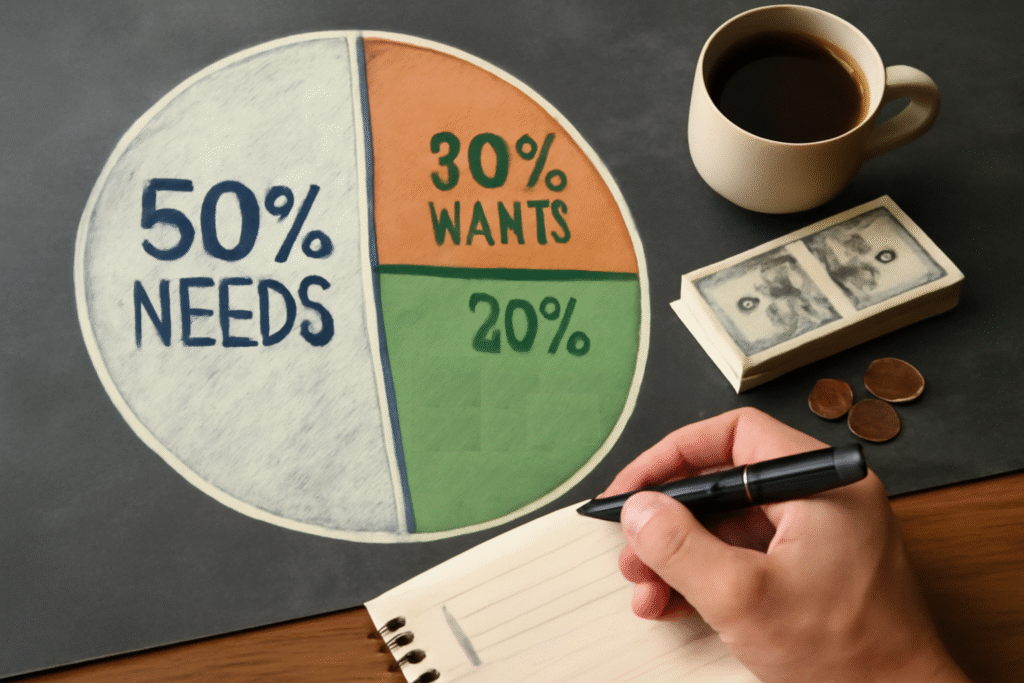A simple way to finally take control of your money
Have you ever felt like your paycheck disappears before the end of the month—and you’re not even sure where it went? You’re not alone. One of the main reasons people lose track of their finances is the lack of a solid plan.
But here’s the good news: there’s a practical, accessible strategy that can help you organize your money without stress — it’s called the 50/30/20 method.
Created by U.S. Senator Elizabeth Warren, this method gained popularity for being simple, efficient, and easy to apply to real life. It helps you divide your income intelligently, balancing essential expenses, lifestyle choices, and long-term financial goals.
In this article, you’ll learn what the 50/30/20 method is, how it works, why it can transform your financial life, and how to start applying it today.
What is the 50/30/20 method?
The 50/30/20 method is a personal budgeting strategy that proposes dividing your net income (what actually hits your bank account after taxes and deductions) into three key categories:
- 50% for needs
- 30% for wants
- 20% for financial priorities (like saving, investing, or paying off debt)
It’s as simple as that. The idea is to find balance between what you must cover, what brings you joy, and what secures your future.
Breaking down the categories
🔵 50% – Needs (essential expenses)
These are the bills and costs you must cover to live. This includes:
- Rent or mortgage
- Utilities (electricity, water, gas, internet)
- Transportation (fuel, public transit)
- Basic groceries
- Health insurance
- Essential education expenses for children
- Medications and basic healthcare
Ideally, all of your essential expenses should fit within 50% of your net income. If they exceed that, you may need to revisit your lifestyle or renegotiate contracts.
🟠 30% – Wants (lifestyle and leisure)
This portion is for non-essential expenses—the things that bring comfort and enjoyment but aren’t required for survival:
- Dining out
- Subscriptions (Netflix, Spotify, etc.)
- Shopping (clothing, accessories)
- Travel and vacations
- Beauty treatments, gym, hobbies
- Entertainment
This part of the budget exists to allow you to enjoy life now, but with moderation. After all, saving everything and never living isn’t sustainable either.
🟢 20% – Financial priorities (future planning)
This is the most powerful part—it’s where you build financial stability and freedom. This category includes:
- Emergency savings
- Investments (stocks, funds, government bonds)
- Debt payments
- Retirement planning
- Saving for major life goals (home, car, education)
If you have debt, this is where you should focus on paying it off first. After that, work on building an emergency fund and investing for long-term growth.
How to apply the 50/30/20 method in real life
Let’s say your net monthly income is $4,000. Here’s how the method would break down:
- 50% ($2,000) for rent, utilities, transport, and groceries
- 30% ($1,200) for dining out, subscriptions, leisure
- 20% ($800) to save, invest, or pay debt
From here, the ideal step is to organize a spreadsheet or use a budgeting app to categorize expenses and track them over time.
Tools to help you apply the method
If you prefer using technology, there are many free financial apps that make it easier to apply the 50/30/20 rule:
- Mint
- YNAB (You Need a Budget)
- PocketGuard
- Spendee
- Goodbudget
- Bank apps like Nubank, Inter, or C6 that offer expense tracking features
Or if you prefer a hands-on approach, you can use a simple Excel or Google Sheets spreadsheet, color-coded by category.
What if your income is variable?
If you’re a freelancer or self-employed, the 50/30/20 method still works, with a few adjustments.
Use an average of your income from the last 3 to 6 months. Base your budget on the lowest month to stay safe, and adjust accordingly.
You can also temporarily modify the percentages: try 60/20/20 in high-expense months, or 40/30/30 if you want to increase savings.
Common mistakes to avoid
Even though it’s simple, the 50/30/20 method requires some discipline. Here are the most common mistakes:
- Confusing wants with needs (e.g., cable TV is a want, electricity is a need)
- Failing to track real spending — a budget only works if you monitor it
- Trying to apply it all at once — start gradually and adjust as needed
- Ignoring debt — it must be addressed before focusing on investments
Why this method actually works
✅ Simplicity: anyone can apply it, no financial expertise required
✅ Flexibility: adapts to different income levels and lifestyles
✅ Awareness: helps you understand where your money goes
✅ Balance: allows you to enjoy life while staying on track
✅ Progress: builds long-term financial habits and freedom
When the method might not be ideal
The 50/30/20 method isn’t one-size-fits-all. It may not be effective in situations like:
- Very low income where needs exceed 50% of earnings
- Households facing high debt
- Times of crisis, like job loss or medical emergencies
In those cases, it’s smart to adjust the ratios temporarily until financial stability is regained.
Conclusion: a simple habit that leads to a healthier financial life
The 50/30/20 rule is a powerful tool for anyone who wants to take control of their finances without complicated systems.
It teaches you to balance responsibilities, pleasure, and planning for the future in a way that’s sustainable and smart.
Remember: financial control isn’t just about earning more—it’s about managing what you already have better.
So, are you ready to try the 50/30/20 method and finally make your money work for you?
